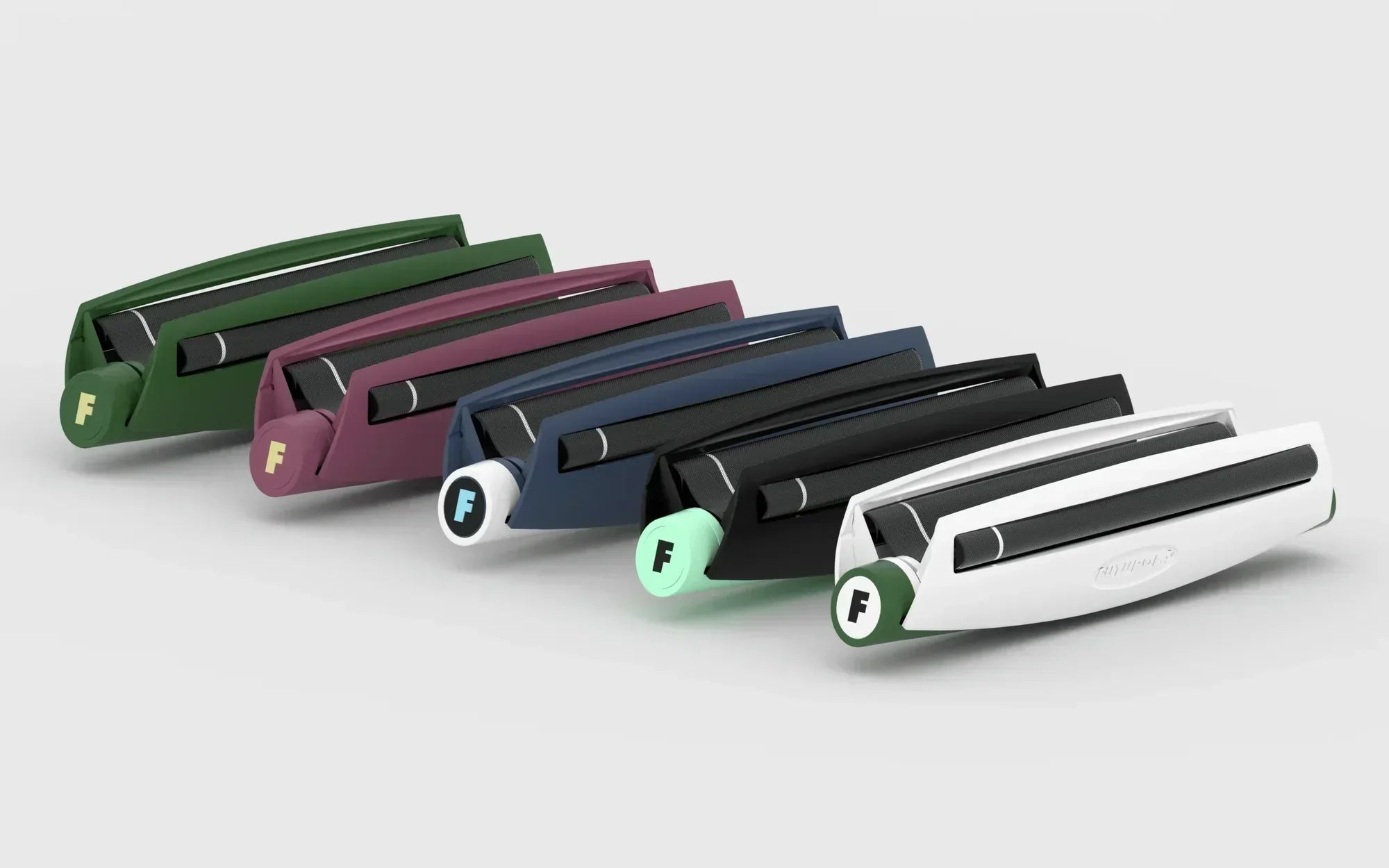Poor rolling paper storage causes three main problems: papers become torn from brittleness, lose adhesive strength, preventing proper sealing, and develop inconsistent performance characteristics that ruin sessions.
Proper rolling paper storage maintains optimal humidity levels of 58-62%, temperatures between 60-70°F, and dark conditions to preserve the paper's flexibility, adhesive quality, and structural integrity. Understanding different rolling paper materials and their properties helps explain why these storage conditions are critical for maintaining paper performance. With the right techniques, papers that last 6-12 months with correct storage can deteriorate within 2-4 weeks under poor conditions, representing a 300-500% improvement in lifespan and significant cost savings.
Environmental Factors That Damage Rolling Papers
Three primary environmental factors can damage rolling papers: humidity fluctuations, temperature changes, and exposure to light. Understanding these threats helps create ideal storage conditions for maximum paper longevity.
Humidity Control Requirements
Rolling papers require a relative humidity of 58-62% for optimal preservation. Below 50% RH causes brittleness and tearing, while above 70% RH promotes mold growth and paper sticking within 24-48 hours.
High humidity causes papers to absorb excess moisture, making them stick together and increasing the risk of mould by 300-400%. Low humidity has the opposite effect, drying papers until they become brittle and prone to cracking, while weakening the adhesive's effectiveness.
Temperature Stability Needs
Maintain storage temperatures between 60°F and 70°F with minimal fluctuation. Temperature swings exceeding 15°F cause fibre expansion and contraction, which weakens the paper structure over time.
Avoid storing items near heat sources, such as radiators, sunny windows, or appliances. Similarly, extremely cold conditions make papers brittle and difficult to handle. Choose locations with consistent temperatures year-round.
Light and UV Protection
UV light exposure breaks down cellulose fibers in rolling papers over 30-90 days, resulting in yellowing, a 40-60% reduction in strength, and increased brittleness. Direct sunlight poses the greatest threat, but even fluorescent lighting causes gradual degradation.
Store papers in dark locations to protect from UV damage while maintaining original color and strength.
Best Storage Solutions and Containers
Effective storage combines airtight sealing with practical accessibility. The right containers maintain stable conditions while keeping papers easily accessible for regular use.
Airtight Container Options
Glass mason jars provide optimal storage through airtight sealing, non-porous construction that prevents odor transfer, and clear visibility for monitoring paper condition. Select small to medium-sized jars that accommodate your typical paper quantity without excessive space.
Food-grade plastic containers with rubber-sealed lids offer affordable storage, weighing 60-80% less than glass while maintaining airtight protection for 6-12 months. Look for containers designed for long-term food storage with better sealing mechanisms.
Metal tins with tight-fitting lids work well for smaller quantities. Clean and dry thoroughly before use. Consider adding parchment paper to prevent direct contact between the paper and metal.
DIY Storage Solutions
Resealable plastic bags provide simple and inexpensive storage when double-bagged with the air removed. While not as effective as rigid containers, this method works for short-term storage or travel.
Small glass jars, such as those used for baby food, spices, or jam, can be cleaned and repurposed. These often feature excellent sealing mechanisms and cost nothing if you have them available.
Vacuum-sealed bags provide exceptional protection for long-term storage or bulk purchases. Use home vacuum sealers or manual vacuum bags designed for food storage.
Advanced Storage Techniques
Humidity control packs automatically maintain optimal RH levels in storage containers, lasting 2-6 months while protecting against external humidity fluctuations of 20-40%. Place one small pack inside your container alongside papers.
Replace packs when they become hard or crystallized. This solution particularly benefits users in very dry or humid climates where maintaining stable conditions proves challenging.
Select storage locations with consistent temperature and humidity levels that are also easily accessible. Interior closets, bedroom drawers, and dedicated storage cabinets work well. Avoid bathrooms, kitchens, and garages prone to environmental fluctuations.
Storage by Paper Type
Different rolling paper materials require specific storage considerations based on their construction and sensitivity to environmental factors. Match your storage approach to your paper preferences for optimal results.
Natural vs. Traditional Papers
Hemp and organic papers require stricter environmental control due to the absence of chemical stabilizers. These papers require consistent conditions within the optimal range, whereas traditional papers with chemical additives can tolerate humidity variations of 10-15%.
Store natural and traditional papers separately if you use both types, as they benefit from slightly different humidity levels within the optimal range.
Flavored Paper Requirements
Flavored papers require completely airtight storage to prevent flavor loss within 30-60 days. Maintaining a temperature below 70°F is crucial to preserve flavor compounds and prevent degradation.
Store different flavors separately to prevent cross-contamination, and avoid storage near strong-smelling substances. Heat breaks down flavor compounds and creates off-tastes, making temperature control even more critical. For those curious about how flavored rolling papers affect taste, proper storage becomes essential to maintain their intended flavor characteristics.
Travel Storage Solutions
Portable storage requires striking a balance between protection and convenience. Hard-shell cases provide excellent protection but may be bulky for everyday carry. Soft pouches offer portability but less protection against crushing or moisture.
Multi-compartment travel cases accommodate papers, filters, and accessories in one organized package. Look for cases with padding or rigid construction to prevent crushing during transport.
Allow stored papers to gradually acclimate to new environments rather than exposing them to sudden changes in temperature or humidity.
Common Storage Mistakes to Avoid
Learning from frequent errors saves frustration and wasted materials. These mistakes can compromise the quality of papers within days or weeks, despite good intentions.
High-humidity location storage: Bathroom and kitchen storage expose papers to 80-90% humidity spikes during showers and cooking, causing moisture damage within hours and reducing lifespan by 70-80%.
Heat source proximity: Storing near radiators, heating vents, sunny windows, or electronics creates low-humidity conditions that make papers brittle and prone to tearing.
Over-handling: Excessive handling transfers skin oils and increases tear risk by 50-70%, while repeated container opening exposes papers to humidity fluctuations.
Inadequate container sealing: Test containers by storing something aromatic inside and checking if you can smell it from outside after 24 hours. If odors escape, air and moisture can enter.
Bulk purchase mismanagement: Poor rotation leads to waste as older papers deteriorate before they can be used. Implement first-in, first-out rotation with clear date labeling.
When to Replace Rolling Papers
Recognizing replacement needs prevents disappointing sessions while maximizing your investment. Proper evaluation significantly extends your supply's effective lifespan.
Quality Assessment Signs
Visual inspection reveals immediate problems. Look for yellowing, brown spots, or visible mould growth, which indicate the need for immediate replacement. Discard any papers showing these signs entirely.
Texture changes signal degradation. Fresh papers maintain smooth texture with moderate flexibility, while degraded papers feel brittle or limp and require replacement.
Test adhesive strips by lightly moistening a small section of the material. Quality papers should stick easily and hold firmly. Weak adhesive indicates the papers won't roll effectively.
Performance during rolling provides the ultimate test. Papers that tear easily, fail to seal properly, or perform unevenly indicate quality deterioration regardless of appearance.
Cost-Effective Rotation Strategies
Label containers with purchase dates and use older stock first, even if newer papers seem more convenient to access. For bulk purchases, divide papers into smaller quantities to limit exposure when accessing your supply.
Monitor storage conditions regularly, especially during seasonal changes. Adjust humidity control, relocate containers, or modify storage methods as environmental conditions change.
Calculate storage investment against replacement costs. A $20 investment in quality containers and humidity control can save hundreds of dollars in paper replacement over time, plus hidden costs such as wasted rolling time and emergency purchases.
Troubleshooting Storage Problems
Even with careful storage, problems occasionally arise. These practical solutions can salvage papers and prevent future issues before they become serious.
Reviving Damp Papers
If papers become slightly damp but show no signs of mold, spread them on clean, dry surfaces at room temperature for 2-4 hours, checking every 30 minutes to prevent over-drying. Avoid direct heat sources like hair dryers, which can make papers become brittle.
For papers sticking together, gently separate using clean, dry hands. Work slowly to avoid tearing, and discard any that tear during separation.
Addressing Over-Dried Papers
Place a slightly damp paper towel in your storage container without direct contact with papers. Monitor closely for 12-24 hours, removing the towel once papers regain normal flexibility.
Check papers every few hours and remove moisture sources as soon as they feel normal to prevent over-humidification.
Emergency Solutions
For travel emergencies, wrap papers in clean paper towels, seal in plastic bags with air removed, and maintain moderate temperatures until proper storage is available. Body heat can protect papers from extreme temperature fluctuations when kept in inside pockets.
Test storage effectiveness by placing a small piece of bread in your container alongside papers. If bread stays fresh for several days, your storage conditions are appropriate.
Adhesive Revival
Papers with weakened adhesives can sometimes be restored by applying light moisture. Breathe gently on the gum strip or use a barely damp fingertip to reactivate the adhesive.
Test adhesive strength before committing to a full roll. If the gum strip won't hold reliably, use alternative sealing methods or replace the papers.
Implementing Your Storage System
Start with three simple steps: assess your current storage situation, choose suitable containers and a location, and establish consistent monitoring habits. These changes require minimal investment but deliver maximum impact on paper quality and longevity.
Focus on consistency rather than perfection when starting your improved storage routine. Good storage habits become second nature with practice, delivering immediate improvements in paper quality and rolling ease. At Futurola, we understand that proper storage is just as important as quality manufacturing in delivering consistent rolling performance.





LEAVE A COMMENT
All comments are moderated before being published.
This site is protected by hCaptcha and the hCaptcha Privacy Policy and Terms of Service apply.